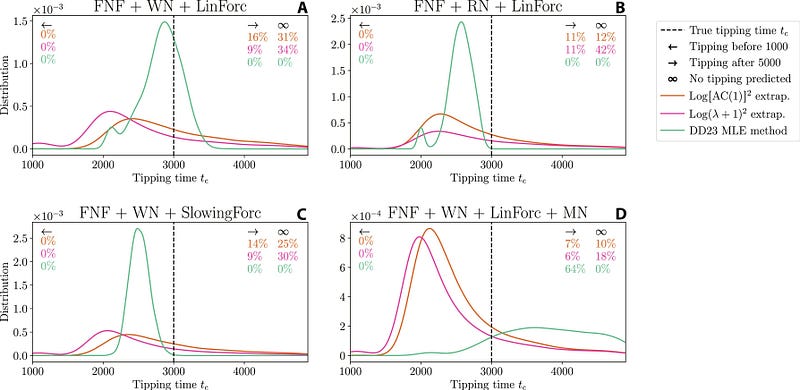Can We Accurately Forecast Climate Collapse Events?
Written on
Understanding Climate Tipping Points
Predicting the exact moment when climate systems may reach their tipping points has been a longstanding objective in climate science. These pivotal moments, where minor cumulative changes can trigger significant and often irreversible alterations in climate dynamics, evoke both intrigue and concern.
People yearn for some degree of control over this uncertain future. When they consult scientists, they seek precision in answers about the timing of potential global shifts. Personally, I share this curiosity, as such knowledge could greatly influence various life choices, from where I settle down to the education I provide for my children.
However, the question arises: can we truly be so precise given the data currently available?
For instance, the Amazon rainforest is at risk of transitioning from a lush ecosystem to a parched savanna due to issues like deforestation and climate change, which could have serious ecological and climatic ramifications.
Similarly, the Atlantic Meridional Overturning Circulation (AMOC) is a critical ocean current system that, if disrupted, could lead to severe climate changes particularly affecting Europe and North America through altered heat distribution.
The first video explains the discrepancies in climate change predictions and highlights the various challenges scientists face in making accurate forecasts.
The Science Behind Climate Predictions
The understanding of these tipping points is clear; we know they can occur and the conditions that would lead us there. So, why is it difficult to pinpoint their timing?
Recent research published in Science Advances by experts from the Technical University of Munich and the Potsdam Institute for Climate Impact Research reveals that our current data and understanding are insufficient for accurately predicting when these catastrophic tipping points might happen.
The study, led by Dr. Maya Ben-Yami and her team, investigated the feasibility of forecasting tipping times for significant Earth system components, including the AMOC, melting polar ice sheets, and the collapse of tropical rainforests.
Three primary sources of uncertainty were identified: the foundational assumptions of prediction models, the representativeness of observational data, and the impacts of data preprocessing. Just how much do these biases affect our analyses?
The researchers utilized various prediction methodologies, including conventional indicators of system stability, which typically increase as a system nears a tipping point—a phenomenon referred to as critical slowing down (CSD). They also employed a maximum likelihood estimation (MLE) technique to evaluate the predictive capacity of historical data, focusing on the AMOC as a case study.

Findings revealed that the uncertainties surrounding climate tipping point predictions are too substantial for reliable estimates. For example, previous forecasts suggested an AMOC collapse could occur between 2025 and 2095, based on overly simplistic models and incomplete datasets. However, when researchers applied different methodologies and datasets, predicted tipping times for the AMOC varied dramatically, ranging from 2050 to 8065. This stark range underscores the complexity and unpredictability involved in such events.
Key Issues in Current Prediction Models
Dr. Ben-Yami’s team pointed out several critical flaws in existing prediction models.
Firstly, many models operate under the assumption of a linear progression of climate forcing, which seldom reflects reality. Climate systems are influenced by numerous factors that interact in complex, often nonlinear ways. For instance, while there is a general trend of increasing temperatures, the actual progression is not uniform but involves fluctuations.
Secondly, the observational data utilized in these models is often limited and incomplete, especially for historical contexts. Addressing these data gaps often requires assumptions and preprocessing that can lead to substantial errors.
Thirdly, the indicators used to forecast tipping points, such as variance and autocorrelation, are particularly sensitive to these uncertainties.

Despite the challenges, the study underscores an important message: while the allure of predicting climate tipping points is compelling, the reality is fraught with difficulties. “Our research serves as both a wake-up call and a cautionary tale,” explains lead author Dr. Maya Ben-Yami. The study clearly indicates that current methods and data are inadequate for accurately forecasting when tipping points will occur.
This reality doesn’t imply that climate science is flawed or that we are without hope. The research highlights that while pinpointing exact tipping times may be elusive, statistical methods can still yield valuable insights about which aspects of the climate system are becoming increasingly unstable and the potential consequences of various scenarios.
The second video delves into how artificial intelligence can reshape climate prediction, offering innovative approaches and solutions.
Moving Forward: The Way Ahead
The study’s findings emphasize the critical need for greater investment in climate data collection and analysis. Enhanced observational techniques, long-term data gathering, and more sophisticated models could ultimately help reduce the uncertainties highlighted by Dr. Ben-Yami and her colleagues, providing a clearer understanding of the situation.
Until improvements are made, the focus must remain on understanding and mitigating the drivers of climate change. Although pinpointing the exact moment of a tipping point may be beyond reach for now, this doesn’t eliminate the possibility that such a tipping point could eventually be crossed.
Recognizing signs of growing instability within our climate systems is essential. By doing so, we can better prepare for and potentially avert the severe consequences these tipping points could entail.
In conclusion, the study serves as a reminder of the intricate nature of our planet's climate and the necessity for cautious, informed strategies in tackling its challenges. As Thomas E. Lovejoy and Carlos Nobre wisely remarked, “There is no point in discovering the precise tipping point by tipping it.”